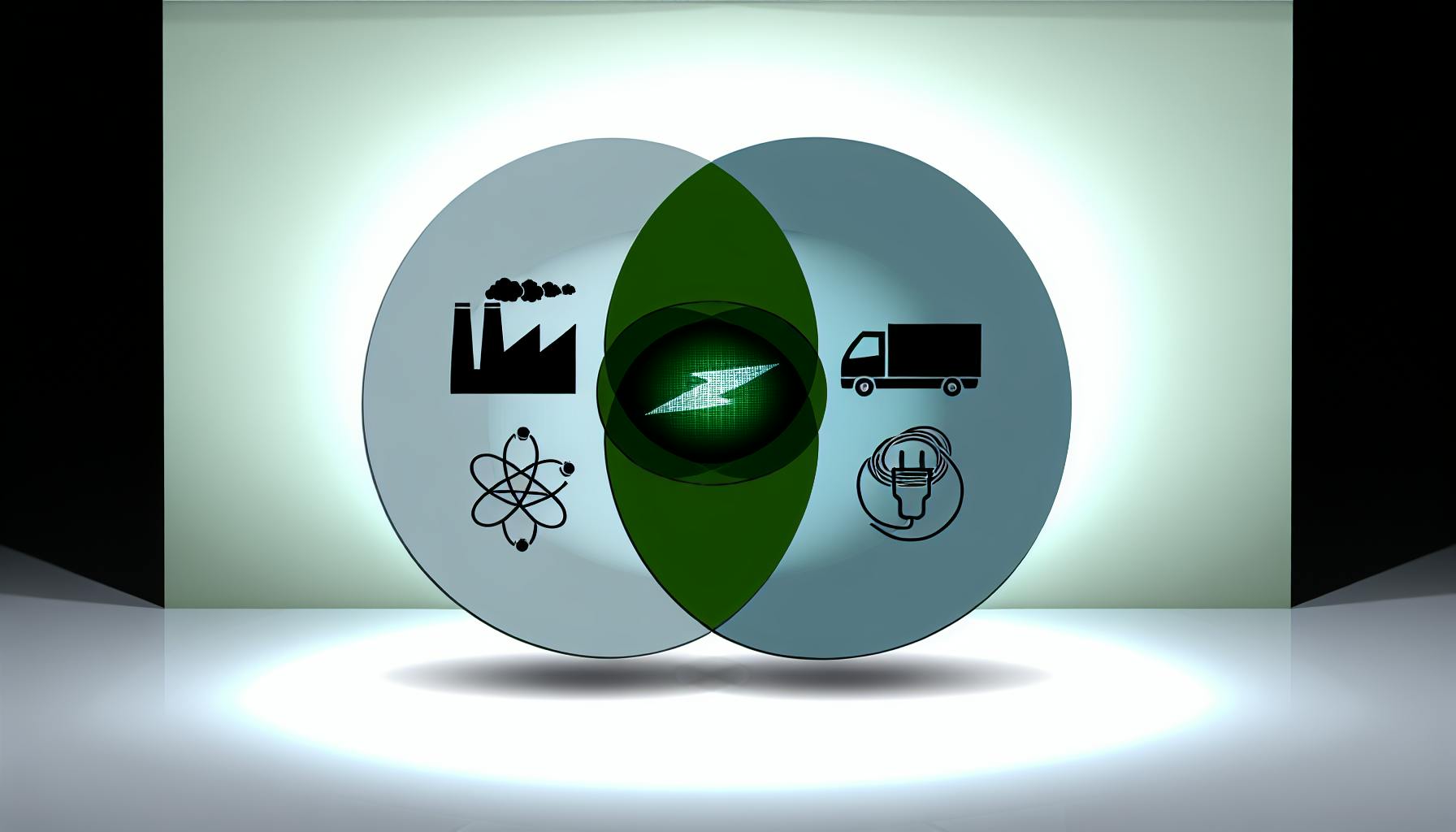It's no secret that decoding sustainability reporting frameworks can be an arduous task for small and medium-sized enterprises.
But it doesn't have to be. This post will provide a simplified, step-by-step breakdown of the GHG Protocol's Scope 3 guidance - tailored specifically for SMEs looking to enhance their sustainability initiatives.
You're going to learn what constitutes Scope 3 emissions, why accurately measuring them matters for SMEs, and how to pragmatically calculate your company's Scope 3 footprint. We'll streamline the core components of the GHG Protocol methodology so you can integrate Scope 3 insights into your business strategy and craft a low-carbon future.
Introduction: Decoding the GHG Protocol Scope 3 Guidance for SMEs
Scope 3 emissions account for the largest share of a company's carbon footprint. This guide simplifies the GHG Protocol Scope 3 Standard and provides actionable insights for small and medium-sized enterprises (SMEs) to measure, report, and mitigate their indirect emissions effectively.
Exploring the Breadth of Scope 3 Emissions
Scope 3 emissions encapsulate all indirect emissions in a company's value chain, spanning the 15 GHG Protocol categories, including:
- Purchased goods and services
- Transportation and distribution
- Waste generated in operations
- Business travel
- Employee commuting
- Leased assets
- Investments
- And more
For SMEs just beginning their sustainability journey, diving into Scope 3 can seem daunting given its expansive nature. However, a basic understanding of where Scope 3 emissions originate from is key to devising a comprehensive carbon strategy.
The Imperative of Measuring Scope 3 for SMEs
Understanding the intricacies of Scope 3 emissions enables SMEs to pinpoint critical emission sources, engage with stakeholders, and initiate targeted sustainability efforts. Specifically, a Scope 3 evaluation allows companies to:
- Identify emission hotspots across the value chain
- Engage suppliers and partners to reduce emissions
- Benchmark against industry peers
- Enhance stakeholder transparency through robust disclosures
While indirect emissions are complex, the GHG Protocol Scope 3 guidance provides a unified framework for SMEs to navigate this challenge. Leveraging Scope 3 best practices tailored for small businesses can unlock material climate action across the complete corporate ecosystem.
What is scope 3 guide GHG Protocol?
The Greenhouse Gas Protocol defines Scope 3 emissions as “all indirect emissions (not included in Scope 2) that occur in the value chain of the reporting company, including both upstream and downstream emissions.” These emissions are a consequence of the company's activities, but occur from sources not owned or controlled by the company.
Scope 3 emissions are often the largest category of emissions for many companies and covering them is key to managing a company's full climate impact. The GHG Protocol has developed guidance and requirements to help companies account for, report on, and reduce Scope 3 emissions.
Some key things to know about Scope 3 guidance:
- It identifies 15 categories of Scope 3 emissions companies should account for if relevant. These include purchased goods/services, transportation, waste disposal, etc.
- Companies should determine which Scope 3 categories contribute significantly to total emissions and prioritize tracking those. GHG Protocol Scope 3 category 15 helps with this assessment.
- There is flexibility to focus on certain categories depending on relevance, data availability, resources, etc. But companies should be transparent about which parts are excluded.
- Over time, companies should work towards accounting for and reporting all relevant Scope 3 emissions as data/methodologies improve. Setting Scope 3 reduction targets is also encouraged.
- Useful resources exist like the Scope 3 Standard and calculation tools, alongside individual category guidance documents.
So in summary, Scope 3 reporting is complex but critically important for managing full value chain emissions. The GHG Protocol guidance aims to enable flexible but comprehensive Scope 3 accounting and emissions reductions over time.
Which of the 3 scopes used in the GHG Protocol?
The GHG Protocol Corporate Value Chain (Scope 3) Standard and GHG Protocol Product Standard both take a life cycle approach to GHG accounting and categorize emissions into three scopes:
Scope 1
Scope 1 includes direct emissions from owned or controlled sources like company facilities and vehicles. Examples of Scope 1 emissions are those produced from on-site fuel combustion for heating or from a manufacturing process.
Scope 2
Scope 2 accounts for indirect GHG emissions from the generation of purchased electricity, steam, heating, or cooling consumed by the company. Although not emitted on-site, these emissions are a consequence of the company's energy use.
Scope 3
Scope 3 emissions are all indirect emissions not already covered in Scope 2 that occur across the company's value chain. This encompasses both upstream and downstream activities such as purchased goods/services, transportation, waste disposal, investments, leased assets, franchises, etc.
With over 15 categories ranging from employee commuting to product end-of-life, Scope 3 emissions are often more complex to measure but can account for the majority of an organization's carbon footprint. Guidance like the GHG Protocol Scope 3 Standard helps businesses estimate these extended emissions.
By taking a comprehensive view across Scopes 1, 2, and 3, companies get valuable visibility into carbon hotspots and opportunities to reduce environmental impact. EcoHedge's software simplifies this assessment, allowing SMEs to enhance sustainability reporting.
What are scope 3 emissions regulations?
Scope 3 emissions refer to indirect greenhouse gas (GHG) emissions that occur in a company's value chain. Unlike scope 1 and 2 emissions, scope 3 emissions occur from sources not owned or controlled by the company.
The GHG Protocol Corporate Value Chain (Scope 3) Accounting and Reporting Standard provides requirements and guidance for companies to prepare a GHG inventory that includes indirect emissions resulting from value chain activities.
Here are some key things to know about scope 3 regulations and reporting:
- Scope 3 reporting is currently voluntary in most jurisdictions, but an increasing number of regulations are making it mandatory for certain companies. For example, the SEC proposed rule may soon require public companies to disclose scope 3 emissions.
- The GHG Protocol Scope 3 Standard defines 15 categories of scope 3 emissions that companies should account for if relevant and applicable. These include emissions from purchased goods/services, transportation, waste disposal, investments, etc.
- Companies must set a scope 3 boundary that reflects their value chain emissions accurately. The guidance helps companies identify emissions hotspots to focus reduction efforts.
- Thorough scope 3 accounting can be complex for SMEs new to emissions reporting. Software solutions like EcoHedge can simplify the process.
By providing clear methodologies for calculating scope 3 emissions, the GHG Protocol empowers companies to improve value chain transparency and identify targeted reduction opportunities. Integrating scope 3 into overall climate strategies is key for SMEs pursuing net-zero emissions goals.
sbb-itb-919600f
How to calculate Scope 3 GHG emissions?
Calculating Scope 3 greenhouse gas (GHG) emissions can seem daunting, but breaking it down into a few key steps makes it more manageable.
The GHG Protocol Scope 3 Standard provides categories and guidance to help companies account for indirect emissions across their value chains. There are 15 categories of Scope 3 emissions, but not all will be relevant to every company.
Prioritize the most significant Scope 3 categories
The first step is to qualitatively evaluate your business activities and identify which Scope 3 categories are likely the most significant for your company. This helps focus calculations on the areas with the largest impact. For SMEs, often the largest categories are purchased goods & services, transportation, waste, business travel, and employee commuting.
Choose calculation methods
There are two main methods for calculating Scope 3 emissions:
- Spend-based: Multiply your spending in each category by an emissions factor associated with that spend. For example, take your annual spend on shipping, and multiply it by an emissions factor for the transportation mode used. This method is easiest when spend data is readily available.
- Activity-based: Multiply an activity metric (e.g. kWh of electricity, tonnes of waste) by an emissions factor. This requires getting data on quantities of activities, but can provide greater accuracy.
Hybrid approaches are also common. The key is using the data you have access to for each category.
Collect data
Data collection poses the most significant challenge for Scope 3 calculations. Consider surveying key suppliers to request activity data or emissions totals. Where supplier data isn't available, industry averages can serve as reasonable proxies. Over time as data quality improves, so will emissions estimates.
Pick emission factors
Emissions factors translate activity data into GHGs. Various databases provide factors, like the UK's Defra and Australia's NGA factors. Pick factors that best match your activities and geography. Consistently using the latest factors each year helps track performance over time.
By following these steps, SMEs can develop a quality Scope 3 inventory to understand the largest sources of value chain emissions, set reduction targets, and communicate progress to stakeholders. Reaching net-zero requires addressing Scope 3, but breaking down the process makes it achievable through focus, good data, and the right tools.
Step-by-Step Approach to the Scope 3 Standard for SMEs
The GHG Protocol's Scope 3 Standard offers a structured approach for emissions accounting. This section demystifies the process, making it accessible for SMEs looking to align their reporting with global best practices.
Establishing Objectives and Defining Emission Boundaries
SMEs first need to clarify their ghg protocol scope 3 guidance measurement objectives and determine the Scope 3 categories most relevant to their operations, factoring in industry-specific nuances and data accessibility.
Here are some best practices to follow:
- Review your company's operations and supply chain to identity emission sources that fall under Scope 3. Refer to the 15 Scope 3 categories defined by the GHG Protocol for guidance.
- Prioritize the top 5-10 categories contributing to the majority of your Scope 3 footprint based on spend, operational control, stakeholder concerns, etc. Attempting to measure all 15 categories initially may prove challenging.
- Consider industry benchmarks and sector-specific guidance to home in on the most applicable Scope 3 sources. For example, category 11 "Use of Sold Products" is highly relevant for consumer goods companies.
- Define your inventory boundary and emissions cut-off threshold, striking a balance between completeness and practical feasibility given data and resource constraints.
Following these principles allows SMEs to anchor their Scope 3 emissions accounting on categories with the highest business impact and data availability.
Streamlining Data Collection for Scope 3 Emissions
Effective data gathering is pivotal for Scope 3 accounting. SMEs can utilize both direct supplier data and estimation techniques, such as the spend-based method, to fill data gaps.
Here are some tips for SMEs getting started:
- Obtain primary data directly from tier-1 suppliers through supplier surveys. Offer non-disclosure agreements for sensitive data.
- For supplier categories with lower spend, utilize secondary data from industry benchmarks, lifecycle analysis software, and published emission factors.
- Leverage the Scope 3 Evaluator for a streamlined estimation of emissions using spend.
- Identify processes for systematic data gathering aligned with your reporting timelines to track performance over time.
- Consider automating data collection where possible by integrating emissions tracking with procurement systems.
Approaching Scope 3 inventory creation pragmatically based on primary supplier data, secondary data sources, and simplified estimation methodologies help SMEs overcome initial data barriers. Consistently enhancing data quality and coverage poises SMEs for advanced Scope 3 reporting over time.
Deep Dive into the GHG Protocol Scope 3 Categories
The GHG Protocol Scope 3 standard encompasses 15 categories covering various types of indirect emissions across a company's value chain. For small to medium-sized enterprises (SMEs), calculating and reporting on all Scope 3 emissions can be an immense undertaking. Instead, it is strategic to focus on the categories which typically make up the majority of emissions for SMEs.
Category 1: Purchased Goods and Services
Scope 3 Category 1 covers emissions from the extraction, production, and transportation of goods and services purchased by the company. For SMEs, purchased goods often represent the largest Scope 3 emission source.
To calculate Category 1 emissions, SMEs need to engage suppliers to provide activity data and emission factors for the goods purchased. This can be facilitated by:
- Prioritizing suppliers representing over 50% of procurement spend
- Using supplier scorecards to track sustainability metrics
- Offering incentives for comprehensive carbon reporting
Once the data is obtained, apply emission factors based on fuel and material inputs. For greater accuracy, utilize product level data rather than industry averages.
Category 11: Use of Sold Products
Category 11 focuses on emissions from the usage and end-of-life treatment of products sold by the company. The methodology varies considerably based on product type:
Consumable goods - Estimate emissions using total units sold and product lifetime assumptions. Apply usage scenarios and emissions factors aligned to the product's function.
Durable goods - Calculate emissions over the lifetime of products sold in the current year. Estimate usage timeframes, efficiency loss, and end-of-life impacts per unit.
Strategies to reduce Category 11 emissions center on product design:
- Increasing material efficiency and extending product lifecycles
- Shifting to lower carbon materials and production processes
- Optimizing energy performance during the use phase
By taking accountability for downstream impacts, SMEs can build trust and loyalty among eco-conscious consumers.
Category 15: Investments
Emissions from investments (Category 15) can be material for SMEs with large cash reserves or financial portfolios. The methodology entails quantifying the company's share of emissions from investments and lending activities.
To approach Category 15, SMEs should:
- Assess all minority equity investments using the equity share approach
- For debt investments, estimate the share of emissions relative to the size of the loan
- Obtain disclosure from fund managers regarding carbon footprints
- Apply emissions factors based on the investee's industry and region
By understanding Category 15 impacts, SMEs can better align investment strategies with net-zero trajectories. This allows managing emissions-related risks and pursuing green investment opportunities.
With a strategic focus on the most relevant Scope 3 categories, SMEs can pave the way for comprehensive value chain decarbonization. The GHG Protocol guidance provides flexibility to prioritize key emission sources while avoiding unnecessary complexity. By taking a phased approach, SMEs can build capacity in sustainability reporting and unlock value through stakeholder engagement.
Practical Tools for Scope 3 Emission Calculation
We introduce SMEs to practical tools and calculators designed to streamline the emissions accounting process, making it easier to adhere to the Scope 3 Standard.
Leveraging the Scope 3 Emissions Calculator
By utilizing a GHG Protocol Scope 3 emissions calculator like the one offered by EcoHedge, SMEs can simplify data analysis and reporting, ensuring they stay on track with their sustainability goals.
The Scope 3 Standard encompasses a company's entire supply chain emissions across 15 categories. For SMEs lacking dedicated sustainability teams, collecting granular data across complex, multi-tier supply chains can be an arduous task. An automated Scope 3 emissions calculator can help by:
- Consolidating supply chain emissions data from disparate sources into a single platform - **Analyzing** emissions according to GHG Protocol categories
- Identifying hotspots and prioritizing high-impact emission reduction opportunities
- Forecasting future emissions based on business plans to model different decarbonization scenarios
- Reporting against major ESG disclosure frameworks like CDP, GRI, and SASB
For example, EcoHedge's Scope 3 emissions calculator features built-in emissions factors drawing from reputable databases like ecoinvent, applies custom allocation logic, and models both historical emissions as well as forward-looking projections. This enables SMEs to efficiently account for upstream and downstream emissions as per Scope 3 category 15.
The granular visibility into Scope 3 emissions empowers SMEs to:
- Set science-based targets encompassing their entire value chains
- Engage suppliers and customers on targeted decarbonization initiatives
- Make informed decisions around low-carbon procurement, logistics, product design, and other key business functions
- Communicate their sustainability credentials to investors, employees, and consumers
Rather than grappling with excel sheets, a purpose-built Scope 3 emissions calculator simplifies adherence to the Scope 3 Standard for resource-constrained SMEs. By leveraging the right tools, small businesses can overcome barriers to comprehensive climate action.
Conclusion: Crafting a Low-Carbon Future with Scope 3 Insights
The GHG Protocol Scope 3 guidance provides a comprehensive framework for SMEs to account for value chain emissions. By measuring and reporting Scope 3 emissions, companies gain visibility into hotspots to address environmental impacts beyond their direct operations.
Though Scope 3 calculations can be complex, taking a simplified approach tailored to business needs empowers SMEs to incrementally improve inventories over time. Prioritizing the most relevant Scope 3 categories is key. For example, focusing first on emissions from purchased goods and services or transportation and distribution may uncover the bulk of Scope 3 emissions for many SMEs.
Rather than viewing sustainability reporting as merely a box-ticking exercise, Scope 3 insights unlock strategic opportunities to collaborate across supply chains. Engaging suppliers on emissions reductions through incentives and support catalyzes market-wide change.
SMEs also gain leverage in stakeholder communications by proactively addressing Scope 3 emissions. Demonstrating concrete climate action and transparency builds credibility with customers, investors and regulators alike.
By taking the first steps to understand value chain impacts, SMEs future-proof operations while accelerating sector-wide decarbonization. Collaborative efforts across industries can drive down costs of low-carbon solutions and technologies. Pursuing sustainability collectively across supply chains thus enables competitive advantage for frontrunners over the long term.
With the right guidance, Scope 3 reporting need not be daunting, but rather the springboard for SMEs to achieve net zero - and shape markets in the transition. This guide aims to be the cornerstone of that journey towards a sustainable future.



